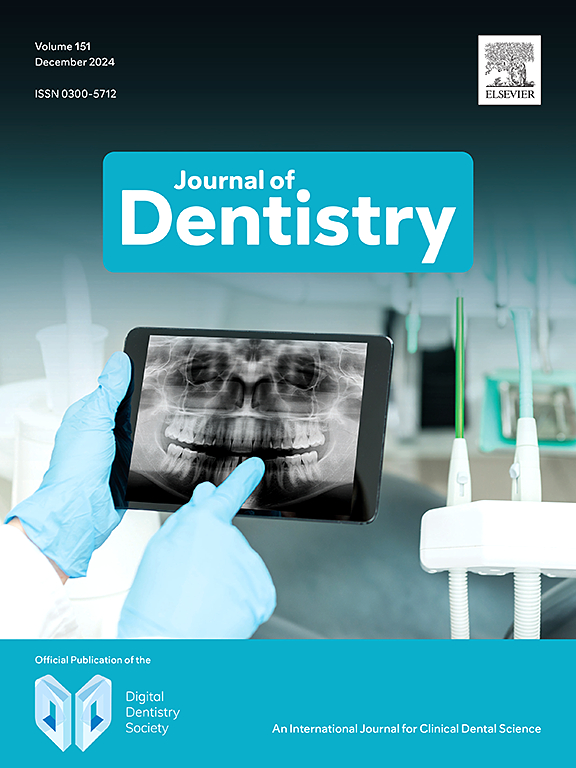Impact of scanning interruptions on accuracy of implant-supported full-arch scans: An in-vitro pilot study
IF 4.8
2区 医学
Q1 DENTISTRY, ORAL SURGERY & MEDICINE
引用次数: 0
Abstract
Purpose
To assess the impact of involuntary interruptions (simulating tracking loss by moving the scanner out of its focal distance) and voluntary interruptions (pressing the scanner's turn-on button) on the accuracy of implant-supported full-arch scans using an intraoral scanner (TRIOS 5, version 22.1.10; 3Shape; Copenhagen, Denmark).
Materials and Methods
An edentulous model with four implants was digitized with an industrial scanner (Artec Micro II; Artec 3D) to create a reference scan. Four groups (n = 30) were established based on the number of interruptions during scanning: Zero Group (no interruptions; control group), 6-V Group (six voluntary interruptions), 6-I Group (six involuntary interruptions), and 12-I Group (twelve involuntary interruptions). Primary outcome was accuracy assessed by the Root Mean Square (RMS) method. Secondary outcomes included scanning time and the number of photograms. Data were analyzed using one-way ANOVA and post hoc Tukey multiple comparison tests (α=0.05).
Results
A total of 120 digital scans were conducted. The Zero group achieved a RMS error of 291 ± 47 µm, a scanning time of 68 ± 6s, and 1320 ± 129 photograms. 6-V group significantly reduced RMS error (MD -102 µm [IC 95 %: -141, -63]), decreased scanning time (MD -20s [IC 95 %: -25, -17]), and reduced photograms (MD -415 photograms [IC 95 %: -506, -324]) compared to the control group (P<.001). Simulations of 6 or 12 involuntary interruptions did not affect accuracy compared to the control group (P>.05).
Conclusions
Voluntary interruptions during scanning, achieved by pressing the scanner's turn-on button, appear to enhance accuracy due to image preprocessing, while involuntary interruptions had no significant impact on the accuracy of implant-supported full-arch scans.
Clinical Significance
Voluntary stop during scanning implant-supported full-arches may result in better-fitting prostheses owing to higher scan accuracy and efficiency.
扫描中断对种植体支持的全弓扫描准确性的影响:一项体外试点研究。
目的:使用口内扫描仪(TRIOS 5,22.1.10 版;3Shape;丹麦哥本哈根)评估非自愿中断(通过将扫描仪移出焦距来模拟跟踪损失)和自愿中断(按下扫描仪的打开按钮)对种植体支持的全牙弓扫描准确性的影响:使用工业扫描仪(Artec Micro II; Artec 3D)对带有四个种植体的无牙模型进行数字化,以创建参考扫描。根据扫描过程中的中断次数分为四组(n=30):零组(无中断;对照组)、6-V 组(六次自愿中断)、6-I 组(六次非自愿中断)和 12-I 组(十二次非自愿中断)。主要结果是采用均方根(RMS)法评估准确性。次要结果包括扫描时间和照片数量。数据分析采用单因素方差分析和事后 Tukey 多重比较检验(α=.05):共进行了 120 次数字扫描。零组的均方根误差为 291 ± 47 微米,扫描时间为 68 ± 6 秒,照片数量为 1320 ± 129 张。与对照组相比,6-V 组的有效值误差(MD -102µm [IC 95%:-141, -63])、扫描时间(MD -20s [IC 95%:-25, -17])和照片数量(MD -415 照片 [IC 95%:-506, -324])均明显减少(P.05):结论:扫描过程中按下扫描仪的开启按钮实现的自愿中断似乎能提高图像预处理的准确性,而非自愿中断对种植体支持的全弓扫描的准确性没有显著影响:临床意义:在扫描种植体支撑的全牙弓时主动停止可能会提高扫描的准确性和效率,从而获得更合适的修复体。
本文章由计算机程序翻译,如有差异,请以英文原文为准。
求助全文
约1分钟内获得全文
求助全文
来源期刊

Journal of dentistry
医学-牙科与口腔外科
CiteScore
7.30
自引率
11.40%
发文量
349
审稿时长
35 days
期刊介绍:
The Journal of Dentistry has an open access mirror journal The Journal of Dentistry: X, sharing the same aims and scope, editorial team, submission system and rigorous peer review.
The Journal of Dentistry is the leading international dental journal within the field of Restorative Dentistry. Placing an emphasis on publishing novel and high-quality research papers, the Journal aims to influence the practice of dentistry at clinician, research, industry and policy-maker level on an international basis.
Topics covered include the management of dental disease, periodontology, endodontology, operative dentistry, fixed and removable prosthodontics, dental biomaterials science, long-term clinical trials including epidemiology and oral health, technology transfer of new scientific instrumentation or procedures, as well as clinically relevant oral biology and translational research.
The Journal of Dentistry will publish original scientific research papers including short communications. It is also interested in publishing review articles and leaders in themed areas which will be linked to new scientific research. Conference proceedings are also welcome and expressions of interest should be communicated to the Editor.
 求助内容:
求助内容: 应助结果提醒方式:
应助结果提醒方式:


